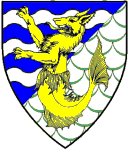| View previous topic :: View next topic |
| Author |
Message |
Sea Wolf
Joined: 01 Nov 2003
Posts: 8650
City/Region: Redding
State or Province: CA
C-Dory Year: 1987
C-Dory Model: 22 Cruiser
Vessel Name: Sea Wolf
Photos: Sea Wolf
|
 Posted: Sat Jun 02, 2007 2:25 pm Post subject: Posted: Sat Jun 02, 2007 2:25 pm Post subject: |
 |
|
Warren-
I'm not a real experienced mooring person, more inclined to use a covered marina when available, so I'm not sure about the block usage. Perhaps Bob Austin (Thataway) can clear this up.
However, here's a very good article on the use of the mooring pendant, quoted below:
MOORING PENDANTS - I like the security of two mooring lines over a single one. If I know a huge storm is approaching I will temporarily add a third line from the bow eye on the stem directly to the chain at the bottom of the float. Give it enough slack so the ball has just enough room to move as if the third line were not there. My two main mooring lines consist of two equal length of 1/2" (minimum) triple plait nylon with a loop spliced at the top end. Set at least six tucks in the splice. Do NOT use a knot. A splice is stronger and lies flat on the deck. These lines should have no more than 1' of slack in calm water to ensure that the bow picks up the chain when the wind starts to blow. This helps to dampen the hunting at the mooring and keeps the ball from bouncing against the hull.. Avoid the temptation to use all the line you bought simply because you don't want to waste it. Pendants longer than described above will droop in the water and then wrap around the chain below the float as the boat ghosts around the mooring float. That's exactly the situation to avoid during a storm as the line will abrade right where it wraps around the chain. Another way to prevent the pendants from wrapping around the chain is to make the lines float by slipping a foam tube over each. Use the type of foam tubing that kids play with in the water. While preventing a line from sinking it also makes it easier to pick up when you approach the mooring. If you use lime green foam they stick out like a sore thumb in the anchorage. Don't use red, you won't be able to see it at night.
Yale cordage introduced a new manufacturing process with 3 strand nylon. Rather than weaving 3 strands into rope, they pioneered a unique eight-strand weave. This new line is called Brait. It is worth investigating as an alternative to triple plait nylon.
Splice a metal thimble in the bottom of the pendant that connects to the float. A metal thimble increases strength and minimizes wear. The rope will soon wear through without the protection of a metal thimble. As you splice the loop around the thimble bind the junction of the lines at the open end of the thimble with a whipping to keep the thimble captive inside the eye. This eye MUST be tight around the thimble. Attach the two lines to the float using a single shackle as shown above. For some reason, two shackles will bind around each other and of course one can't! I have no explanation for why this happens except that it happens. Just take my word for it! Now that you've become an expert at splicing, splice another loop at the deck end of each line. Make this loop just large enough to slip over the deck mooring cleat. This is a very convenient and secure method for quickly fastening the boat. See picture below. If you want extra security, tie a light line over the cleats to lock the heavy ones in place. My lines have never slipped off their cleat since 1980. .
A splice retains approximately 90% of the original strength of the line. A bowline retains approximately 80% of the strength and all other knots about 65%. This is the reason why riggers always splice. Besides, a splice is far more compact than a knot and lies flat on the deck.
Before you splice in the top loops, slip a 2' length of 3/4" rubber garden hose over the line. This is the cheapest and BEST chafe gear you can use. If this combination is too thick to pass through your mooring cleat, the cleat is too small. Replace it with a bigger one.
NOTE: Don't use polypropylene line as UV deteriorates the line quickly and it doesn't have as much stretch as nylon. The muskrats love to chew on poly. They have razor sharp teeth that make real quick work of a 1/2" line. The incision resembles a knife cut so don't be mislead into thinking this is a malicious event.
 Look closely to see metal thimbles inside loops of rope at the shackle pin! Also note shackle is siezed with wire. Look closely to see metal thimbles inside loops of rope at the shackle pin! Also note shackle is siezed with wire.
DECK FITTINGS - The pendants or nylon mooring lines should each pass through a mooring chock mounted on the edge of the deck and then terminate at a deck mounted cleat. All deck fittings MUST be firmly through bolted, equipped with a generous solid wood backing plate and sealed to the deck with marine adhesive, Sikaflex. Use a large metal plate that straddles both mounting bolts of the chock or cleat to distribute the load equally. Use nylock nuts on the bolts to ensure they stay tight with vibration. Marine sealant on all fittings prevents movement and water leakage. Imagine that you have to hold 1/3 of the boat's weight from the cleats! Use 3/4" rubber garden hose (not vinyl) as chafe gear around your pendants as shown at right. Slip the line through the hose BEFORE splicing your loops in the end.
Check everything monthly and annually.
 Look closely to note all chafe guarding, chocks, cleats, braiding, and siezing. Look closely to note all chafe guarding, chocks, cleats, braiding, and siezing.
The original article is HERE.
Joe. 
_________________
Sea Wolf, C-Brat #31
Lake Shasta, California
  
"Most of my money I spent on boats and women. The rest I squandered'. " -Annonymous |
|
| Back to top |
|
 |
Captains Cat
Joined: 03 Nov 2003
Posts: 7313
City/Region: Cod Creek>Potomac River>Chesapeake Bay
State or Province: VA
C-Dory Year: 2005
C-Dory Model: 22 Cruiser
Vessel Name: Captain's Choice II
Photos: Captain's Cat
|
 Posted: Sat Jun 02, 2007 5:29 pm Post subject: Posted: Sat Jun 02, 2007 5:29 pm Post subject: |
 |
|
Quite a setup Joe 
I think if you got down to the boat on a Tuesday, you could be underway by Wednesday afternoon at the latest!! 
Seriously though, it looks very secure. Why trust a $50K boat to $15 bucks worth of line!! 
Charlie
_________________
CHARLIE and PENNY CBRAT #100
Captain's Cat II 2005 22 Cruiser
Thataway (2006 TC255 - Sold Aug 2013)
Captain's Cat (2006 TC255 - Sold January 2012)
Captain's Kitten (1995 CD 16 Angler- Sold June 2010)
Captain's Choice (1994 CD 22 Cruiser- Sold Jun 2007)
Potomac River/Chesapeake Bay
K4KBA |
|
| Back to top |
|
 |
Sea Wolf
Joined: 01 Nov 2003
Posts: 8650
City/Region: Redding
State or Province: CA
C-Dory Year: 1987
C-Dory Model: 22 Cruiser
Vessel Name: Sea Wolf
Photos: Sea Wolf
|
 Posted: Sat Jun 02, 2007 7:48 pm Post subject: Posted: Sat Jun 02, 2007 7:48 pm Post subject: |
 |
|
| Captains Choice wrote: | Quite a setup Joe 
I think if you got down to the boat on a Tuesday, you could be underway by Wednesday afternoon at the latest!! 
Seriously though, it looks very secure. Why trust a $50K boat to $15 bucks worth of line!! 
Charlie |
Charlie-
Of course, it's not my boat.....
But we sailors* really know how to get things done right on the water!
*Like you, me, Bob Austin, Wild Blue's Jim H, Larry H, etc, etc., about half the C-Dory crowd (!)
Joe. 
Last edited by Sea Wolf on Sat Jun 02, 2007 8:18 pm; edited 1 time in total |
|
| Back to top |
|
 |
thataway
Joined: 02 Nov 2003
Posts: 20814
City/Region: Pensacola
State or Province: FL
C-Dory Year: 2007
C-Dory Model: 25 Cruiser
Vessel Name: thataway
Photos: Thataway
|
 Posted: Sat Jun 02, 2007 8:05 pm Post subject: Posted: Sat Jun 02, 2007 8:05 pm Post subject: |
 |
|
I have never kept a boat permently on a mooring. But there are a lot of weak points in a mooring system. The usual Pennant on a mooring is the line which attatches the chain to the boat. It is usually line--either braded, plait or three strand. The usual mooring relies on chain as the main connection with an anchor--there is a heavy chain, then a lighter chain, which often goes to or thru the mooring ball, or float. Finally the Pennant attatches to the boat.
Chafe is certainly a problem with moorings, so is the shackle--consider that many shackles are only a fraction of the working load of the chain and rest of the mooring system. I have used several of the round thimbles, and I agree that they do seem to allow less chafe, but are harder to work with, especially in our normal "anchoring". I have one 300 foot combination nylon/dacron plaited line which has these round thimbles in it--it was surpluss and used for towing Navy targets. You can only put the pin of the shackle thru it--so you have to use two shackles if you wanted to use chain--where as the usual thimble will allow only one shackle.
Definately in storm conditions, one must have good chafing gear--and I assume that any one who is on a perment mooring will have good chafing grear. I have always used fire hose--(courtesy of my fireman friends). It is softer than plastic hose, which will heat and work harden. I like to tie my chafing gear onto the line or Pennant.
My concern with a skene type of chock is that it is only screwed (but with 5200 that may well be strong enough)--into the deck, and if the line comes out of the chock, it might chafe against an anchor roller or some sharp object.
_________________
Bob Austin
Thataway
Thataway (Ex Seaweed) 2007 25 C Dory May 2018 to Oct. 2021
Thisaway 2006 22' CDory November 2011 to May 2018
Caracal 18 140 Suzuki 2007 to present
Thataway TomCat 255 150 Suzukis June 2006 thru August 2011
C Pelican; 1992, 22 Cruiser, 2002 thru 2006
Frequent Sea; 2003 C D 25, 2007 thru 2009
KA6PKB
Home port: Pensacola FL |
|
| Back to top |
|
 |
SeaSpray
Joined: 12 Mar 2004
Posts: 1007
City/Region: Brentwood, CA
State or Province: CA
C-Dory Year: 2004
C-Dory Model: 22 Cruiser
Vessel Name: SeaSpray
Photos: SeaSpray
|
 Posted: Sat Jun 02, 2007 8:55 pm Post subject: Posted: Sat Jun 02, 2007 8:55 pm Post subject: |
 |
|
On a CD22 ia it best to put chocks as far forward as you can or further back?
Steve |
|
| Back to top |
|
 |
thataway
Joined: 02 Nov 2003
Posts: 20814
City/Region: Pensacola
State or Province: FL
C-Dory Year: 2007
C-Dory Model: 25 Cruiser
Vessel Name: thataway
Photos: Thataway
|
 Posted: Sat Jun 02, 2007 9:57 pm Post subject: Posted: Sat Jun 02, 2007 9:57 pm Post subject: |
 |
|
| If you are using a mooring pennant, you would want chocks foreward--if you are in a slip, then chocks further aft. You would prefer not having any change in the fairlead angle of the line when passing thru the chock--but most are installed so that there is an angle, and thus induce chafe. |
|
| Back to top |
|
 |
SeaSpray
Joined: 12 Mar 2004
Posts: 1007
City/Region: Brentwood, CA
State or Province: CA
C-Dory Year: 2004
C-Dory Model: 22 Cruiser
Vessel Name: SeaSpray
Photos: SeaSpray
|
 Posted: Sat Jun 02, 2007 10:07 pm Post subject: Posted: Sat Jun 02, 2007 10:07 pm Post subject: |
 |
|
Right now my boat is securely moored to my trailer on dry land. At some point I plan on spending significantly more time cruising and trailering.
I guess the question should have been: are chocks needed if you trailer?
Thanks,
Steve |
|
| Back to top |
|
 |
|
|
You cannot post new topics in this forum
You cannot reply to topics in this forum
You cannot edit your posts in this forum
You cannot delete your posts in this forum
You cannot vote in polls in this forum
You cannot attach files in this forum
You cannot download files in this forum
|
|

 Search
Search Private Messages
Private Messages Profile
Profile Log in
Log in Register
Register Help
Help








